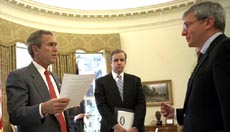
|
Agency Collaboration Creating Citizen Benefits
The E-Gov and Lines of Business initiatives continue to work towards improving government efficiency and effectiveness through back office consolidations, streamlining processes, and reducing the number of duplicative systems. Additionally, the E-Gov initiatives continue to maintain focus on the major goal of improving service to citizens.
A recent event focused on service to citizens was the launch of the new Recreation.gov website, which allows citizens to reserve "their place under the stars" on the Internet web site or with a phone call, regardless of the federal agency offering the opportunity. Citizens now can search sites based on multiple criteria opening the opportunity to explore new locations or search on a specific recreation site. Additionally, another citizen-focused initiative, GovBenefits.gov, is preparing to celebrate its 5-year anniversary of providing a single point of access for citizens to locate and determine potential eligibility for government benefits and services. Initiatives Update Recreation One-Stop: Recreation One-Stop makes it easier for citizens to plan a vacation and make a reservation for a campsite, cabin, or tour at Federal recreation sites. The initiative provides a customer-friendly recreation portal (www.recreation.gov) with information for planning visits to more than 3,200 Federal recreation sites. Recently, the Department of the Interior re-launched their one-stop internet site, www.recreation.gov, for making reservations and exploring federal recreation lands. "Americans love to enjoy our parks, forests, historic sites and other public lands and we want to make it easier for them to do so," said Interior Secretary Dirk Kempthorne. "At Recreation.gov, Americans can find, plan and reserve their 'place under the stars' on one internet website or with a single phone call." Agriculture Secretary Mike Johanns added, "Recreation.gov not only simplifies reservations, it showcases the many opportunities to enjoy public lands. This is a refreshing change for those who have searched multiple web pages to make their recreation plans and it's an example of better coordination to better serve Americans." The interagency web site allows the public to view photos and information on thousands of recreation sites and activities from sightseeing at the Washington Monument to canoeing in a Minnesota forest. The public can also use the recreation.gov site to make reservations and payments online GovBenefits.gov: GovBenefits.gov significantly reduces the amount of time individuals spend identifying and accessing relevant information about government benefit programs matching their specific needs. The website allows local government or social service caseworkers to quickly identify and match alternative programs with an individual's specific needs. Since its inception, the number of citizens using GovBenefits.gov to locate benefit information has increased to over 305,000 visitors a month in 2006 from an average of 35,000 visitors a month in 2002. Recently, GovBenefits.gov was recognized as a semifinalist for the Innovations in American Government Award. The website will now compete for a $100,000 grant from the Ash Institute for Democratic Governance and Innovation at Harvard University's John F. Kennedy School of Government. E-Rulemaking: As recognition of its successes, E-Rulemaking received an American Council for Technology 2007 Excellence.gov award for its efforts in "leveraging technology to enhance collaboration". E-Rulemaking is a prime example of cross-agency resources collaborating to provide citizens with new and improved services. Before E-Rulemaking, each of the approximately 150 rulemaking entities had their own process for handling regulatory dockets resulting in a decentralized and complicated regulatory environment for processing the approx. 30,000 regulatory actions annually. As the Federal Government moves towards a more citizen-centric government, agencies will increasingly use cross-agency initiatives, such as E-Rulemaking, to present a single view of citizen services.
IT Privacy and Security Quarterly security performance updates have demonstrated government-wide progress toward achieving the IT security goals of the E-Gov Scorecard and implementing the privacy provisions of E-Gov Act and the Privacy Act. Currently, agencies improved their rates of security control testing by 5% over the last quarter, from 78% to 83%. As we improve security controls, we will be better poised to decrease security risks. Also, for 80% of applicable systems, agencies have made publicly available how federally owned information is maintained and disclosed.
Federal Enterprise Architecture (FEA) |